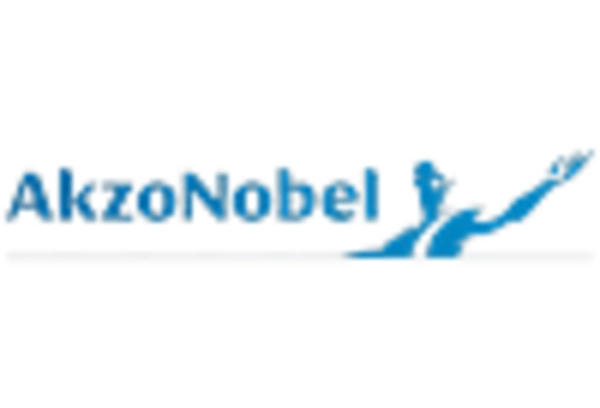Rising Demand in Textile Industry
The textile industry is a major consumer of bleaching chemicals, particularly sodium hypochlorite and hydrogen peroxide. As the US textile market continues to expand, driven by increasing consumer preferences for high-quality and vibrant fabrics, the demand for bleaching agents is likely to rise. In 2025, the textile sector is projected to account for approximately 30% of the total consumption of bleaching chemicals in the US. This growth is attributed to the need for effective bleaching processes that enhance fabric whiteness and colorfastness. Furthermore, the trend towards sustainable textiles may also influence the bleaching chemicals market, as manufacturers seek eco-friendly alternatives that do not compromise on performance. Thus, the interplay between textile production and bleaching chemicals market dynamics is expected to be significant in the coming years.
Growth in Household Cleaning Products
The household cleaning products segment is experiencing notable growth, which is positively impacting the bleaching chemicals market. With an increasing focus on hygiene and cleanliness, particularly in residential settings, the demand for effective cleaning agents is on the rise. In 2025, the household cleaning segment is estimated to represent around 25% of the overall bleaching chemicals market in the US. Products containing bleaching agents, such as laundry detergents and surface cleaners, are favored for their stain removal and disinfecting properties. This trend is further fueled by consumer awareness regarding the importance of sanitation, especially in kitchens and bathrooms. As manufacturers innovate and introduce new formulations, the bleaching chemicals market is likely to benefit from this expanding consumer base.
Expansion of the Paper and Pulp Industry
The paper and pulp industry is a significant contributor to the bleaching chemicals market, utilizing various bleaching agents to achieve desired whiteness and brightness in paper products. As the demand for paper products remains steady, driven by both traditional and digital printing needs, the bleaching chemicals market is poised for growth. In 2025, the paper and pulp sector is expected to account for approximately 20% of the total market share. The industry is increasingly adopting advanced bleaching technologies that enhance efficiency while reducing environmental impact. This trend indicates a potential shift towards more sustainable practices within the paper and pulp sector, which could further bolster the demand for innovative bleaching chemicals. Consequently, the interplay between industry growth and bleaching chemicals market dynamics is likely to remain strong.
Regulatory Compliance and Safety Standards
The bleaching chemicals market is significantly influenced by regulatory compliance and safety standards imposed by government agencies. In the US, the Environmental Protection Agency (EPA) and other regulatory bodies enforce stringent guidelines regarding the use and disposal of bleaching agents. These regulations aim to minimize environmental impact and ensure consumer safety. As a result, manufacturers are compelled to invest in research and development to create safer and more environmentally friendly bleaching chemicals. This shift not only aligns with regulatory requirements but also caters to the growing consumer demand for sustainable products. In 2025, it is anticipated that compliance with these regulations will drive innovation within the bleaching chemicals market, leading to the introduction of safer alternatives that meet both regulatory and consumer expectations.
Increased Awareness of Environmental Impact
There is a growing awareness among consumers and industries regarding the environmental impact of bleaching chemicals, which is shaping the market landscape. As sustainability becomes a priority, stakeholders are increasingly seeking eco-friendly alternatives to traditional bleaching agents. This shift is likely to influence the bleaching chemicals market, as manufacturers respond to consumer preferences for greener products. In 2025, it is projected that the demand for environmentally friendly bleaching agents will increase by approximately 15%, reflecting a broader trend towards sustainability. Companies that invest in developing biodegradable and less harmful bleaching chemicals may gain a competitive edge in the market. This heightened awareness of environmental issues is expected to drive innovation and reshape the product offerings within the bleaching chemicals market.

















Leave a Comment